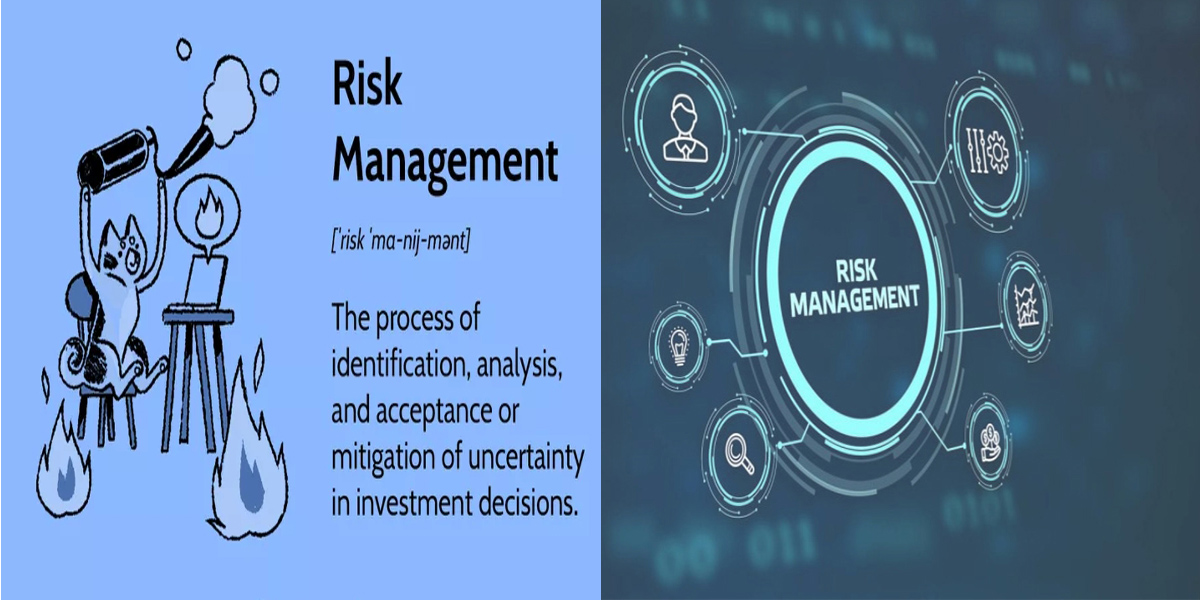Finance
What Is Risk Assessment, Types of Risk Assessment and Seven Steps for Risk assessment

What Is Risk Assessment?
Risk assessment is a standard term used across many industries to decide the likelihood of loss on an asset, loan, or funding. Assessing risk is essential for determining how worthwhile a specific investment is and the first-rate way to mitigate risk. It affords the upside reward as compared to the risk profile. Risk assessment is important, which will determine the price or rate of return of an investor might need to earn to deem an investment worth the potential risk.
Key factors
- Risk assessment is the procedure of analyzing the capacity of an activities that could bring about the lack of an asset, loan, or funding.
- Companies, governments, and traders conduct risk assessments before embarking on a new inverstment, enterprise, or project.
- Quantitative risk analysis makes use of mathematical models and simulations to assign numerical values to risk.
- Qualitative risk analysis is based on someone's subjective judgment to construct a theoretical model of risk for a given situation.
- While a stock's past volatility does not guarantee future returns, it is known in general, that an investment with high volatility indicates a riskier investment.
- Understanding Risk Assessment
- Risk assessment permits businesses, governments, and investors to assess the possibility that a negative event might negatively affect an enterprise, economy, challenge, or investment. Risk analysis presents distinctive strategies investors can use to assess the risk of a potential investment opportunity.We have two major varieties of risk analysis an investor can practice while evaluating investment plan which are quantitative analysis and qualitative analysis.
Quantitative Analysis
A quantitative analysis of risk focuses on constructing risk model and simulations that enable the person to assign numerical values to risk. An example of quantitative risk evaluation would be a Monte Carlo simulation. This technique—which may be utilized in a variety of fields consisting of finance, engineering, and technological know-how—runs some of the variables through a mathematical version to find out the exclusive viable results.
Qualitative Analysis
A qualitative analysis of risk is an analytical technique that does not depend on numerical or mathematical analysis. Instead, it uses a person's subjective judgment and revels to build a theoretical version of chance for a given state of affairs. A qualitative analysis of an enterprise would possibly consist of an assessment of the employer's management, the relationship it has with its carriers, and the general public's belief in the business enterprise.
Important
Investors often use qualitative and quantitative analysis at the side of one another to provide a clearer veiw of an agency's with higher capacity of investment.
Other Risk Assessment Methods
Another example of a formal risk assessment technique consists of conditional price of the risk, which portfolio managers use to lessen the chance of incurring large losses. Mortgage creditors use mortgage-to-value ratios to evaluate the risk of lending money/fund. Lenders additionally use credit analysis to decide the creditworthiness of the borrower.
Risk Assessments for Investments
Both institutional and individual investments have anticipated quantities of risk. This is, in particular, the actual of non-assured investments, which include stocks, bonds, mutual budgets, and exchange trade funds (ETFs).
Standard deviation is a messure carried out to the yearly rate of return of funding to determine the investment's volatility. In some cases, funding with excessive volatility indicates a riskier investment. When figuring out between numerous shares, investors will frequently examine the usual deviation of each inventory before making a investment choice.
However, it is critical to be aware that an stock's past volatility does no longer expects future returns. Investments that previously experienced low volatility can revel in sharp fluctuations, particularly at some point of hastily converting market condition.
Risk Assessments for Lending
Lenders for personal loans, lines of credit score, and mortgages also conduct risk assessment tests, referred to as credit tests. For example, it is common for lenders not to approve debtors who have credit scores below 400 because decreased scores are indicative of poor credit practices. A lender's credit evaluation of a borrower might also not forget different elements, inclusive of available assets, collateral, earnings, or funds at hand.
Risk Assessments for Business
Business risk are widespread and vary throughout industries. Such risks include new competitors coming into the marketplace, employee theft, statistics breaches, product recalls, operational, strategic, and financial risks, and natural catastrophe risks.
Every business ought to have a risk control method in the area to assess its current risk stages and put in force approaches to mitigate the worst viable ricks. A powerful risk management approach seeks to find a balance between protecting the business enterprise from pontential risks without hindering growth. Investors prefer to invest in businesses that have a history of appropriate risk control management.
Young businessmen and partnerships retain a pen pointing to the graph to analysis the marketing plan with a calculator and laptop computer on a wooden desk in the workplace.
Advertising (text continue below)
The seven-step risk control method is to carried out in a very systematic manner to make certain specific results and assist in making excellent decisions:
Advertising (text continue below)
- Establishing the Context: This consists of making plans for the system and mapping out the scope, the identification, and objectives of stakeholders, how risks might be evaluated, defining a framework for the process, and the agenda for identification and analysis of potential dangers.
- Identification of dangers and threats: The subsequent step, in a controlled manner,, is to pick out capacity risks that, once brought about, will cause trouble. Failure to perceive dangers or to have precise analysis ought to motivate foremost liabilities for commercial enterprise. Risk identification can start by figuring out the primary source of the problems or the trouble itself. It requires the expertise of the commercial enterprise, the enterprise’s market together with the felony, social, economic, political, and climatic surroundings—its economic strengths and weaknesses, its vulnerability to unplanned losses, the producing methods, and the control systems used.
- Assessment of risk: After dangers are recognized, they want to be assessed on the idea in their capacity severity of loss and on the number of instances they have befell if you want to determine the opportunity of occurrence. One of the challenges with danger control is that statistical facts of the price of occurrence from past incidents are generally unavailable and are greater than guesses. The risk evaluation ought to be capable of producing these statistics so that it is less complicated to apprehend the number one danger.
- Potential Risk Treatments: Once risks are recognized and assessed, all techniques to control those dangers fall into one or more of those 4 classes: Risk Transfer – the business at fault transfers the entire or a part of the losses consequential to risk publicity to any other birthday celebration for a price, commonly an insurance organization. Risk Avoidance – avoid the dangers or the circumstances that may additionally result in losses in some other manner; however, doing so also can prevent the possibility of incomes income. Risk Retention – implies that the losses because of hazard will be retained or assumed utilizing the celebration or the enterprise. Risk Reduction – risks are decreased via preventative measures or through techniques set in the vicinity if an incident does occur.
- Create the Plan: Next, you’ll want to determine the aggregate of strategies for use for each threat. Each risk management selection must be recorded exactly and approved by using the proper degree of control or venture managers. The risk management plan should recommend relevant and powerful security controls for handling the dangers. A powerful hazard management plan has to endorse, an agenda of security management implementations and list men and women liable for managing the dangers.
- Implementation of the Risk Management Plan: Now that you have your plan in the region, it’s crucial to comply with all the planned strategies for mitigating the effects of the dangers and keep a file of your development or where there may be gaps. It’s critical to educate management and employees appropriately so they are aware of the plan and understand what is needed to execute it.
- Review and Evaluation of Plan: Lastly, modifications inside the plan may be wished based totally on practices, losses, and reports. Risk analysis and control plans must be up to date frequently to, examine if the chosen safety controls are nonetheless applicable and powerful evaluate the feasible danger stage modifications inside the business environment Initial danger management plans will by no means be perfect. To create a pleasant risk management plan that is viable, tactics are up to date continuously.
did you read these yet?

Ademola Lookman wins 2024 African footballer of the year
Football: 3 months, 4 weeks

The Richest Businessman in Nigeria Aliko Dangote Reduced the Price of Primun Moto Spirit (PMS) know as ...
Homeland: 3 months, 4 weeks

Finland New work visa policies is To Attract International Professionals This 2025.
Foreign Countries: 3 months, 1 week
the most reade
- British-Nigerian professional boxer Anthony Oluwafemi Olaseni Joshua OBE popularly ....
- Six Good Food The Kidney Need To BE Heathy During …
- United Kingdom has included Israel among Forty-seven other countries to …
- Best Four Phone To Use this 2025 and its Specifications.
- Ghanain president have done the marvelous by opening up visa-free …
- Israel Defence Force says It opened fire on Syria protest …
- Nigerians Presidents Bola Ahmed Tinubu Couldn't Continue his Trip to …
- Iran manufacturing its own version of Boeing, Airbus engine parts:
- The Richest Businessman in Nigeria Aliko Dangote Reduced the Price …
- Ademola Lookman wins 2024 African footballer of the year
Comments (0)